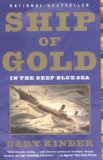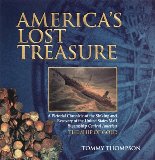
![]() An avid reader pal of mine, artist Donna Romero, had to do a lot of persuading to get me to read Gary Kinder’s Ship of Gold in the Deep Blue Sea
An avid reader pal of mine, artist Donna Romero, had to do a lot of persuading to get me to read Gary Kinder’s Ship of Gold in the Deep Blue Sea. This non-fiction book tells the story of the wreck of the “Central America,” laden with gold from the California Gold Rush, and Tommy Thompson, the treasure-hunting inventor who found her more than 130 years later. It sounded like a tedious science nerd chronology. But Donna persisted and I will be forever thankful I succumbed.
I’ve rarely read a book more gripping, whether fiction or non-fiction, and it’s gripping on many levels, from learning first-hand about the shipwreck from records left by survivors to being privy to Thompson’s creative process in trying to locate then recover the treasure to the mastermind tactics needed by Thompson and his crew to avoid the cutthroat competition from other treasure hunters closing in on their find. Gary Kinder shadowed Tommy and his crew to write this well-researched book and his words compellingly convey both the history and the action.
“For years [Tommy Thompson] had carefully cultivated a creative mind-set, worrying that if he ever stopped being different, if he ever stopped experimenting, if he ever stopped pushing and questioning and exploring and looking at life upside down, he would no longer think the thoughts that could lead him to ask the questions that no one else had asked, which is what made him unique, which is what allowed him to be what he had always wanted to be since he was a small boy: an inventor. He wanted to take old ideas, turn them inside out, and apply them in new ways; he wanted to suck the world through his senses and exhale a vision.”
By the end of Ship of Gold, I was full to the brim with mental pictures, replete with the reality brought to life by Kinder’s tale, and I was glad to let the book’s words inform my mind’s eye without outside assistance. Then I discovered Tommy Thompson’s America’s Lost Treasure, which is filled with stunning photographs.
By the time Donna and I sat on her couch and opened the cover of America’s Lost Treasure, we had both finished reading Ship of Gold. When we saw the lush photographs – of the treasure, the machines and equipment Thompson and his crew engineered, the crew itself, and more – we found ourselves laughing with the glee of being reunited with dear friends. We kept saying things like, “Look! There it is!” – as though we’d been on Thompson’s ship ourselves and were now looking at photos of our own journey. It felt like making the discoveries twice, getting double the pleasure from the story of the recovery of the “Central America.” Her story, told through Gary Kinder and Tommy Thompson, is history brought back to vivid life, a fascinating look inside the process of invention, and a window into the world of high-stakes treasure hunting.
